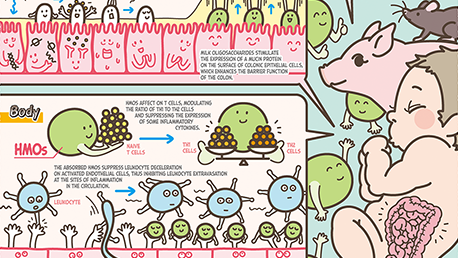Human mature milk contains around 11.3 g/L of human milk oligosaccharides (HMOs) as an average concentration, which is the third largest solid component after lactose and lipid. Around 200 HMO structures have been characterized to date, and they are classified into 21 series based on core structures, none of which contain fucose (Fuc) and N-acetylneuraminic acid (Neu5Ac) (Fig 1). Representative HMO structures are shown in Fig 2. Other HMOs exist only in trace amounts in human milk. When breastfed infants drink their mothers’ milk, a major part of the HMOs is not absorbed in the small intestine to reach the colon. HMOs perform the following biological functions: (1) they stimulate the growth of the beneficial colonic bacteria including bifidobacteria, (2) they inhibit infection by pathogenic microorganisms, (3) they affect immune modulation, (4) they inhibit the development of necrotizing enterocolitis (NEC) by strengthening colonic barrier function, and (5) they stimulate nerve and brain function, etc. At present, only a few HMOs have been manufactured on an industrial scale and used as additives to infant formula in several overseas countries, and the number of cohort studies showing correlation between the health status of breastfed infants and the profile of HMOs in their mothers’ milk, as well as in vivo or in vitro studies, demonstrating biological functions is rapidly increasing. We summarize the history of HMOs studies in Japan in this mini review, and address what the future may hold for HMOs studies as well as steps toward commercializing HMOs in Japan....and more
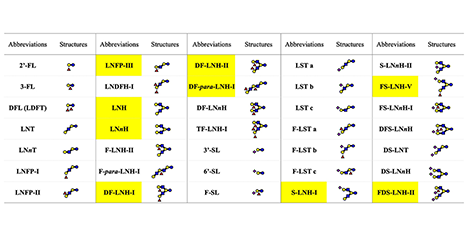
Urashima gave a lecture entitled “The predominance of type 1 oligosaccharides is a feature specific to human breast milk” in May of 2011 at the first human milk oligosaccharides (HMOs) glycobiology meeting held by Glycom A/S (now Royal DSM) in Copenhagen. In this lecture, he proposed that type 1 oligosaccharides are predominant in human milk based on the comparison of the chemical structures as well as profiles of oligosaccharides in human milk with those in the milks of other mammals including non-human primates, carnivora, cetartiodactyla, proboscidea, marsupials, monotremes, etc. However, as some papers previously maintained that lacto-N-neotetraose (LNnT), a type 2 HMO, is the most dominant oligosaccharide in human milk, his hypothesis was not well accepted. However, the hypothesis of LNnT predominance was based on the peak’s height in the HMO elution profiles on high – performance liquid chromatography (HPLC), even though the LNnT peak was not well separated from that of lacto-N-tetraose (LNT), a type 1 HMO. The quantitative data provided by Thurl et al. (2010), who determined the concentrations of some representative HMOs out of the around 200 known HMOs, showed that the ratios of LNT vs LNnT, as well as the ratios of the saccharides containing LNT core vs those containing LNnT core, were 4-5 fold higher in the former (LNT and saccharides containing LNT core) than in the latter (LNnT and saccharides containing LNnT core) in the breast milk of secretor donors, and higher still in the milk of the non-secretor donors. As the number of citations of this paper now exceeds 450, the premise should be generally accepted. Thus, the predominance of type 1 HMOs over type 2 is the consensus view at present. ...and more
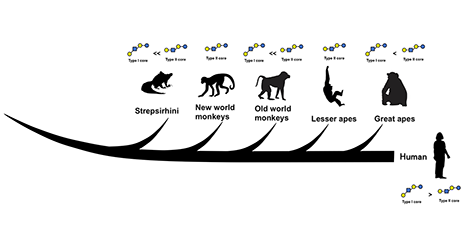
Human milk oligosaccharides (HMOs) are a diverse group of more than 250 compounds found in human milk and are the third most abundant solid component in breast milk, after lactose and lipids. Until relatively recently, the functions of these HMOs were not well understood because of the difficulty of obtaining them at high quantity and purity and at reasonable cost1). However, technological innovations have so far produced 2'-fucosyllactose (2'-FL), 6'-sialyllactose (6'-SL), and 3'-sialyllactose, and their important physiological functions have been revealed. Such functions include the prevention of infection by pathogens and viruses, improvement of intestinal barrier function, immunomodulatory effects such as anti-inflammatory properties, modulation of intestinal bacterial growth as exemplified by promotion of the growth of beneficial intestinal bacteria such as bifidobacteria, and facilitation of brain development1,2,3. Historically, the preparation of HMOs was carried out by extraction from milk, enzymatic synthesis, and whole-cell reaction, but currently, the direct fermentation method is widely used for manufacturing HMOs (Figure 1). This paper reviews and outlines the history of technological development and the future prospects of practical HMO production. ...and more
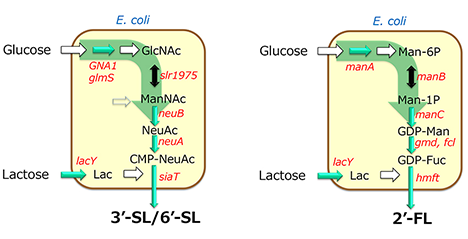
An increasing body of work has shown that the gut microbiota plays an important role in human health and disease, and the microbial colonization of the infant gut that occurs postpartum is a critical period for gut microbiota development. Furthermore, the gut microbiota that forms during infancy can have long-term effects that last into adulthood5. As a result, therapeutic interventions aimed at regulating the gut microbiota, such as probiotics (microorganisms administered exogenously) and prebiotics (indigestible compounds that promote the growth of specific gut microbes), have become increasingly popular. For example, probiotic taxa such as bifidobacteria and prebiotics like human milk oligosaccharides (HMOs) are administered to encourage the development of a healthy gut microbiota in preterm infants. Despite increasing use, studies report conflicting results and host response to microbiota-based therapies are highly variable. Based on recent in vitro and in vivo studies, I discuss how ecological processes like priority effects (i.e. the effect of species arrival order on community structure) and the presence of prebiotic HMOs can alter the structure of the infant gut microbiota and influence the effectiveness of such microbiota-based therapies. ...and more
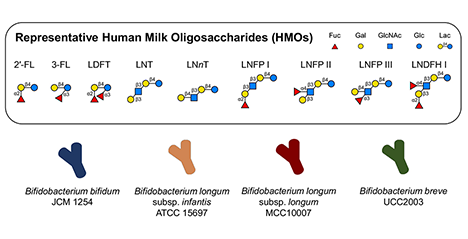
Human milk oligosaccharides (HMOs) is the general term for the complex sugar molecules (oligosaccharides) in human breast milk. HMOs are known to be important nutrients for infants because of their great abundance in human colostrum but only trace amount in bovine milk (Fig. 1). Therefore, efficient large-scale production of HMOs is desired to enhance the nutritional value of infant formula. However, HMO production was not easy. Limited numbers of HMOs can be obtained by using natural extraction methods. Although there are several reports on the chemical synthesis of HMOs including 2'-FL, chemical synthesis of HMOs is still inefficient for industrial production purposes. HMOs consist of saccharide moieties with numerous hydroxy groups and should be attached in a stereospecific manner. In order to reduce the synthesis of unexpected byproducts, protection of the hydroxy groups is required, further complicating synthesis. Enzymes which evolved over time can be used to easily produce complicated oligosaccharide chains with position-dependent activity in a stereospecific manner. So, nowadays, most HMOs are produced biologically. ...and more

Sialic acid was first isolated from bovine submaxillary gland mucin by Blix in 1936, and more than 50 types of sialic acid have been identified to date. Sialic acid is a general term for neuraminic acid derivatives of negatively charged carboxyl group-containing nine-carbon acidic amino saccharides, which can be classified according to the carbon-5 position into three types: N-acetylneuraminic acid (Neu5Ac), N-glycolylneuraminic acid (Neu5Gc), and deaminoneuraminic acid. Sialic acid is closely related to various biological phenomena and is essential for maintaining the development of the human brain and nervous system and regulating the immune system. Sialic acid is also associated with colonization by symbiotic microorganisms, including bacteria, viruses, and fungi. Therefore, sialic acid is extremely important for understanding the host-microorganism symbiotic relationship. In this study, we review sialic acid metabolism by the gut microbiome and its effects on the physiological state of the host. ...and more

Human milk oligosaccharides (HMOs), which are abundant in human breastmilk, have a prebiotic effect that selectively promotes the growth of bifidobacteria. As a result, breastfed infants often have a bifidobacteria-rich gut microbiota, with bifidobacteria accounting for over 50 % of the total bacterial community. Given this, the application of HMOs to infant formula has begun to make progress in recent years. 2ʹ-Fucosyllactose (2ʹ-FL), a representative species of HMOs decorated with fucose (fucosylated HMOs; FHMOs), was the first HMO species approved for use in infant formula and has attracted attention worldwide. In this chapter, I will describe the diverse FHMO utilization strategies found in bifidobacteria, focusing on their glycosidases and transporters, and discuss the significance of FHMOs applied to fortify infant formula in terms of promoting the formation of a bifidobacteria-rich microbiota. ...and more
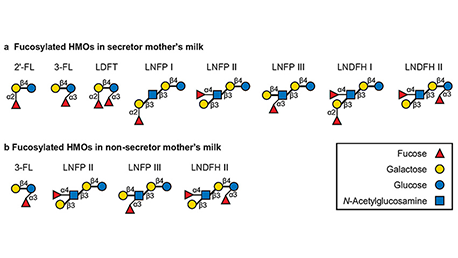
In general, a bifidobacteria-predominant microbiota is established in breastfed infant guts, and such microbiota formation is believed to be beneficial to host health. Since the isolation of Bifidobacterium sp. in 1899, research has been conducted to elucidate how bifidobacteria proliferate in the infant gut and which components, if present, in breastmilk promote their growth. In the 1950s, human milk oligosaccharides (HMOs) were reported to act as a growth factor for bifidobacteria. However, until relatively recently, the structural complexity of HMOs has hampered the elucidation of the molecular mechanism underlying HMOs-mediated selective growth of bifidobacteria. In the early 21st century, systematic understanding of the HMO utilization mechanism of bifidobacteria rapidly advanced. In this chapter, we describe the historical aspects and recent progress of the research on HMOs and bifidobacteria. ...and more
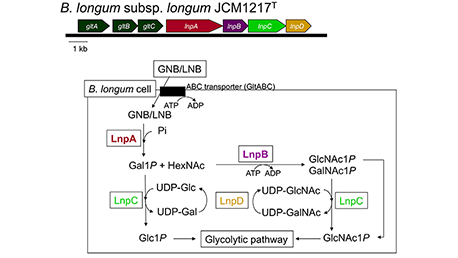
Human milk contains 7% of carbohydrate, 80% of which consists of lactose (Galβ1-4Glc), while 20% consists of oligosaccharides. The concentrations of milk oligosaccharides are 12 ~ 13 g/L in mature milk and 22 ~ 24 g/L in colostrum; these are the third largest solid component after lactose and lipid. Their concentrations are surprisingly high. Most of the human milk oligosaccharides (HMOs), with few exceptions, contain a lactose unit at their reducing ends, to which monosaccharides residues including N-acetylglucosamine (GlcNAc), galactose (Gal), fucose (Fuc), and N-acetylneuraminic acid (Neu5Ac) are attached. To date about 250 HMOs have been separated, of which about 170 structures have been characterized. When breast-fed infants consume their mothers’ milk, the lactose is hydrolyzed to Glc and Gal by small intestinal lactase, to be absorbed, whereas most HMOs remain intact within the small intestine and thus reach the colon, where they have significant physiological functions other than nutritional effects. Based on the experimental evidence, the following functions have been proposed: stimulation of the growth of beneficial colonic bacteria such as bifidobacterium, anti-infection against pathogenic bacteria and viruses, immune modulation including anti-inflammation, prevention of necrotizing enterocolitis and reinforcement of the colonic barrier function, and activation of brain-nerve functions. In this series of Glycoforum, some of the exciting discoveries will be described, focusing on the metabolic pathways of HMOs by bifidobacteria, the functions of HMOs relating to the cross talk between colonic bacteria and host epithelial cells, and the industrial production of HMOs. In this series the history of studies in this field, with future aspects, will be dynamically expanded by first-class researchers. In the beginning of this series, international studies clarifying the biological functions of HMOs will be introduced. ...and more
